Protocol of the Low Birth Weight South Asia Trial (LBWSAT), a cluster-randomised controlled trial testing impact on birth weight and infant nutrition of Participatory Learning and Action through women's groups, with and without unconditional transfers of fortified food or cash during pregnancy in Nepal
- PMID: 27769191
- PMCID: PMC5073870
- DOI: 10.1186/s12884-016-1102-x
Protocol of the Low Birth Weight South Asia Trial (LBWSAT), a cluster-randomised controlled trial testing impact on birth weight and infant nutrition of Participatory Learning and Action through women's groups, with and without unconditional transfers of fortified food or cash during pregnancy in Nepal
Abstract
Background: Low birth weight (LBW, < 2500 g) affects one third of newborn infants in rural south Asia and compromises child survival, infant growth, educational performance and economic prospects. We aimed to assess the impact on birth weight and weight-for-age Z-score in children aged 0-16 months of a nutrition Participatory Learning and Action behaviour change strategy (PLA) for pregnant women through women's groups, with or without unconditional transfers of food or cash to pregnant women in two districts of southern Nepal.
Methods: The study is a cluster randomised controlled trial (non-blinded). PLA comprises women's groups that discuss, and form strategies about, nutrition in pregnancy, low birth weight and hygiene. Women receive up to 7 monthly transfers per pregnancy: cash is NPR 750 (~US$7) and food is 10 kg of fortified sweetened wheat-soya Super Cereal per month. The unit of randomisation is a rural village development committee (VDC) cluster (population 4000-9200, mean 6150) in southern Dhanusha or Mahottari districts. 80 VDCs are randomised to four arms using a participatory 'tombola' method. Twenty clusters each receive: PLA; PLA plus food; PLA plus cash; and standard care (control). Participants are (mostly Maithili-speaking) pregnant women identified from 8 weeks' gestation onwards, and their infants (target sample size 8880 birth weights). After pregnancy verification, mothers may be followed up in early and late pregnancy, within 72 h, after 42 days and within 22 months of birth. Outcomes pertain to the individual level. Primary outcomes include birth weight within 72 h of birth and infant weight-for-age Z-score measured cross-sectionally on children born of the study. Secondary outcomes include prevalence of LBW, eating behaviour and weight during pregnancy, maternal and newborn illness, preterm delivery, miscarriage, stillbirth or neonatal mortality, infant Z-scores for length-for-age and weight-for-length, head circumference, and postnatal maternal BMI and mid-upper arm circumference. Exposure to women's groups, food or cash transfers, home visits, and group interventions are measured.
Discussion: Determining the relative importance to birth weight and early childhood nutrition of adding food or cash transfers to PLA women's groups will inform design of nutrition interventions in pregnancy.
Trial registration: ISRCTN75964374 , 12 Jul 2013.
Keywords: Cash transfer; Food supplement; Low birth weight; Maternal health; Nepal; Newborn; Nutrition; Pregnancy.
Figures
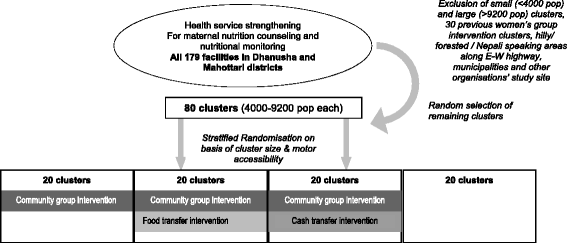

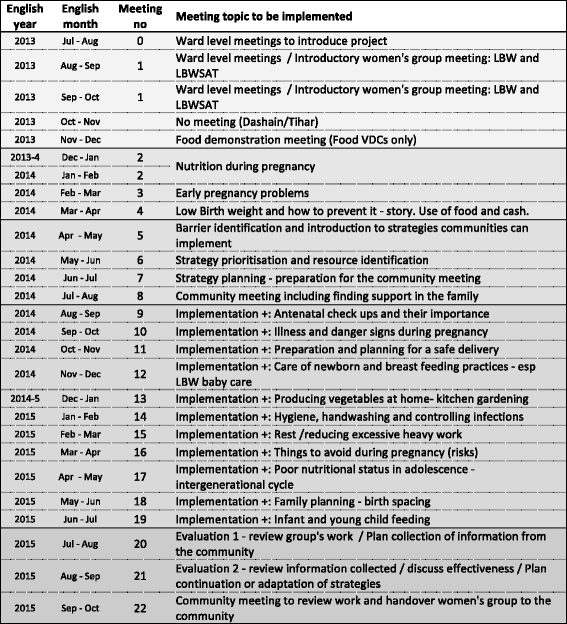
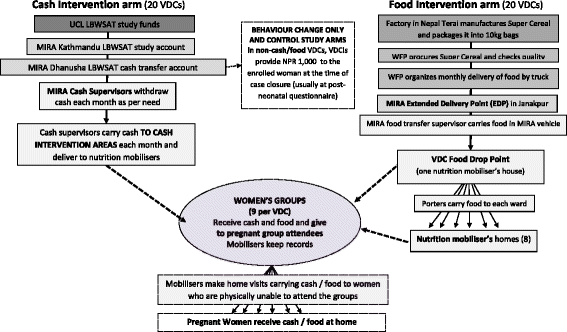
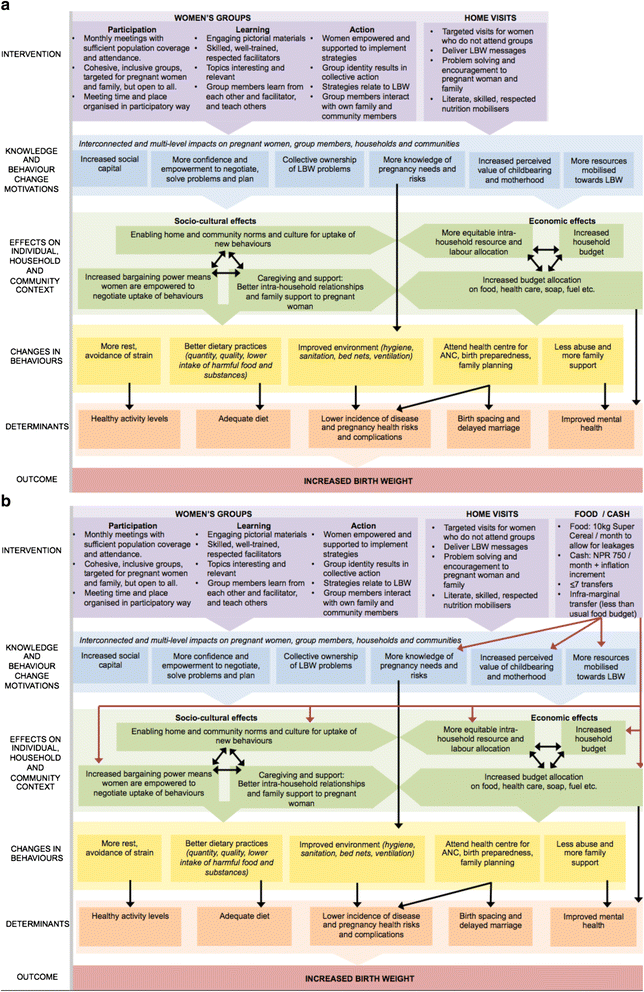
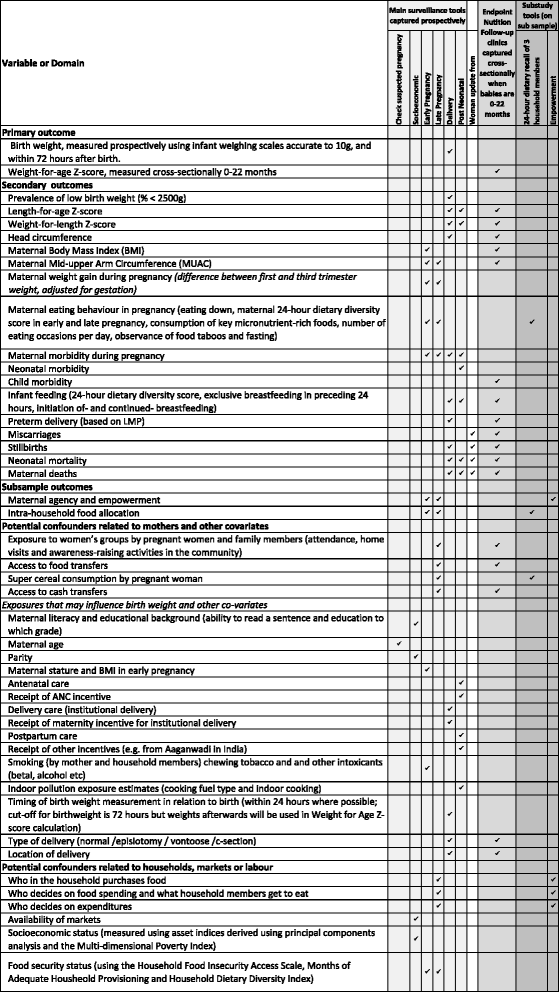

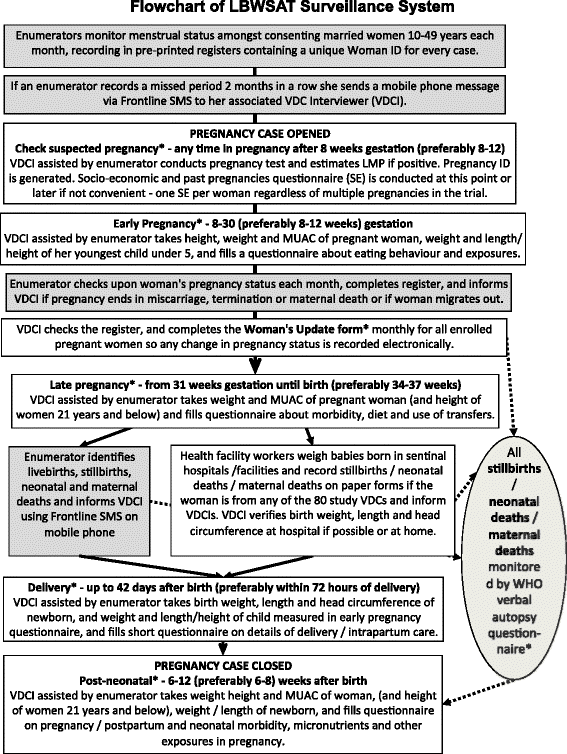

References
-
- Manandhar DS, Osrin D, Shrestha BP, Mesko N, Morrison J, Tumbahangphe KM, Tamang S, Thapa S, Shrestha D, Thapa B, et al. Effect of a participatory intervention with women’s groups on birth outcomes in Nepal: a cluster randomised controlled trial. Lancet. 2004;364:970–9. doi: 10.1016/S0140-6736(04)17021-9. - DOI - PubMed
-
- Tripathy P, Nair N, Barnett S, Mahapatra R, Borghi J, Rath S, Rath S, Gope R, Mahto D, Prost A, Costello A. Effect of a participatory intervention with women’s groups on birth outcomes and maternal depression in Jharkhand and Orissa, India: a cluster randomised controlled trial. Lancet. 2010;375:1182–92. doi: 10.1016/S0140-6736(09)62042-0. - DOI - PubMed
-
- Lewycka S, Mwansambo C, Rosato M, Kazembe P, Phiri T, Mganga A, Chapota H, Kainja E, Malamba F, Newell M-L, et al. Effect of women’s groups and volunteer peer counsellors on mortality, morbidity and health behaviours among mothers and children in rural Malawi: the MaiMwana factorial cluster randomised controlled trial. Lancet. 2013;381:1721–35. doi: 10.1016/S0140-6736(12)61959-X. - DOI - PMC - PubMed
-
- Prost A, Colbourn T, Seward N, Azad K, Coomarasamy A, Copas A, Houweling TA, Fottrell E, Kuddus A, Lewycka S, et al. Women’s groups practising participatory learning and action to improve maternal and newborn health in resource-limited settings: systematic review and meta-analysis. Lancet. 2013;381:1736–46. doi: 10.1016/S0140-6736(13)60685-6. - DOI - PMC - PubMed
Publication types
MeSH terms
Grants and funding
LinkOut - more resources
Full Text Sources
Other Literature Sources

